Warning: pic heavy, as usual. 
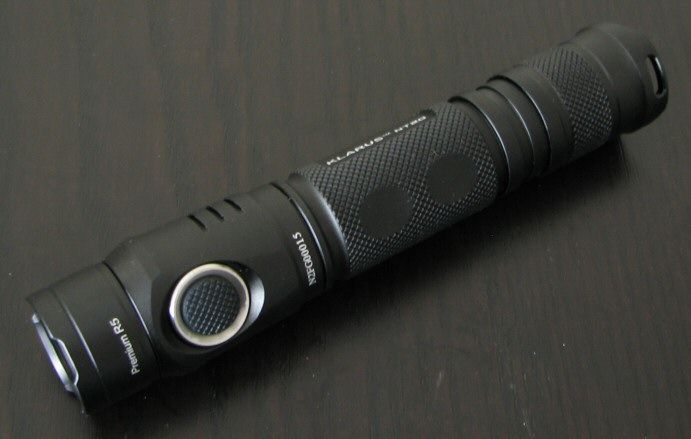
Specifications:
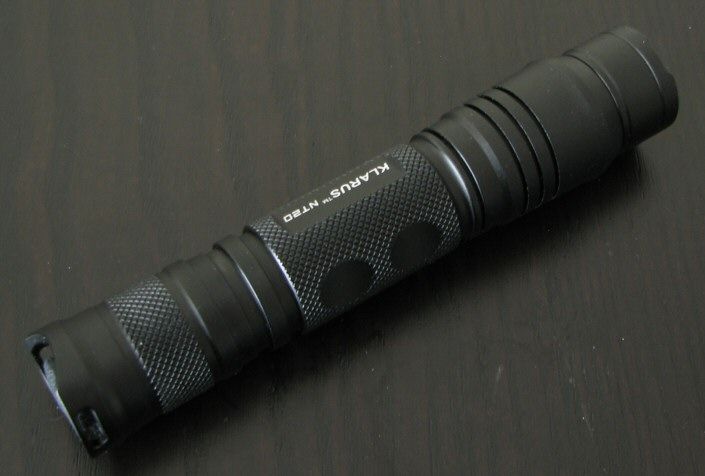
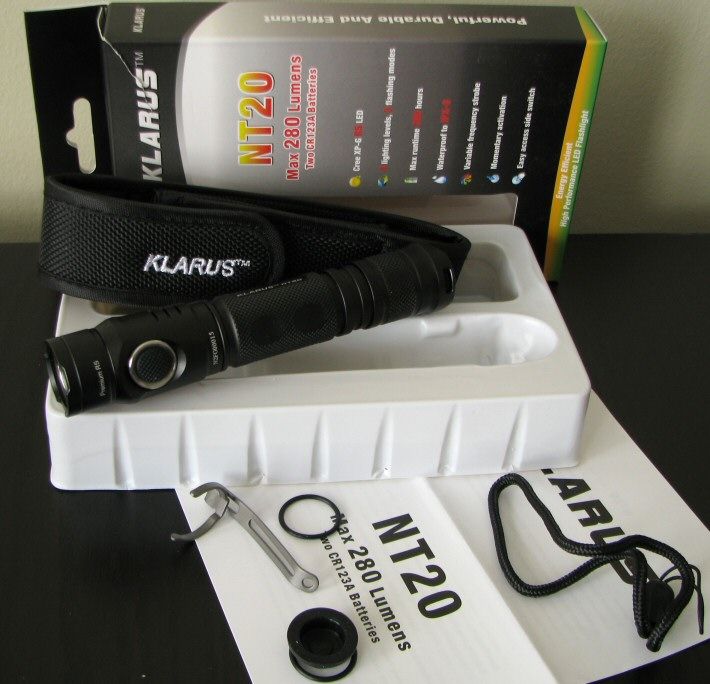
As before, packaging is fairly standard. The light comes with a good number of extras. Inside the cardboard box with plastic insert is the light, manual, spare o-rings, extra boot cap, wrist strap, pocket clip, and belt holster (with closing flap).
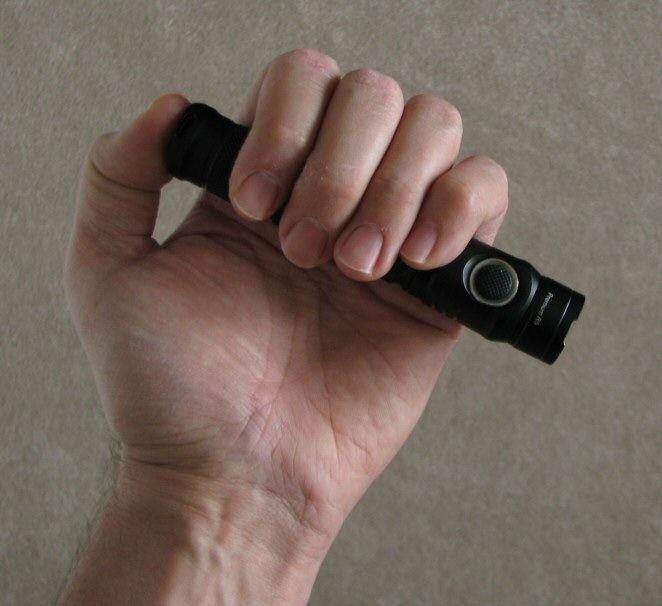
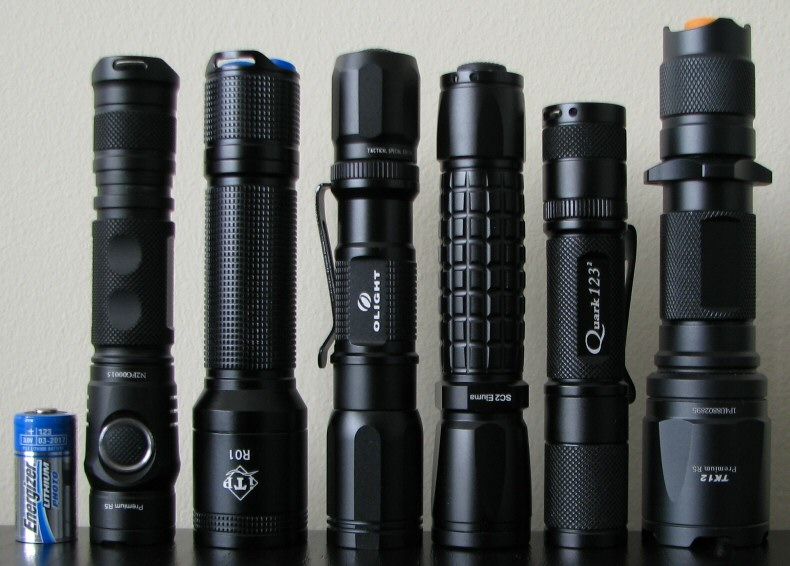
From left to right: Energizer CR123A, Klarus NT20, ITP R01, Olight I20, ITP SC2, 4Sevens Quark 123-2, Fenix TK12
ST-10: Weight: 59.5 g (no battery), Length 124.9mm x Width 22.5mm (bezel) 25.2mm (widest area, near switch)
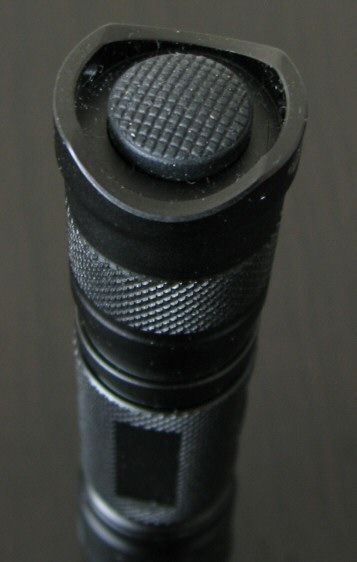
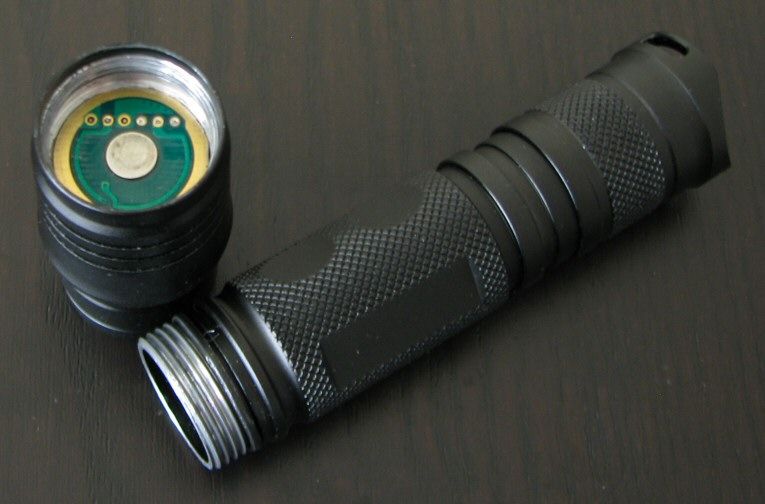
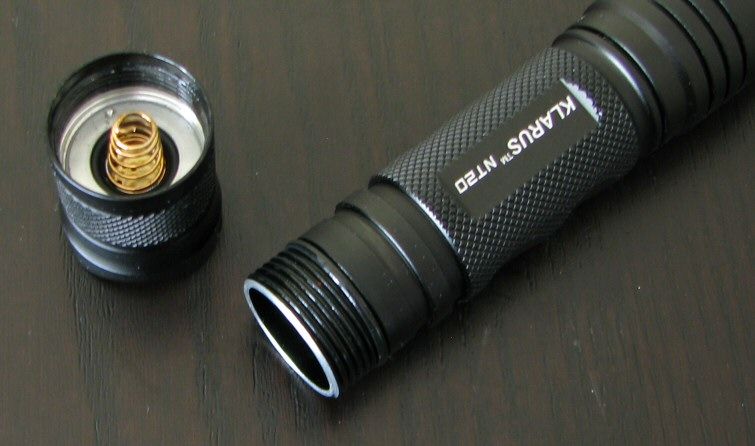
Build quality is excellent. Note the square-cut threads at both ends of the battery tube. Screw threads are anodized at the tailcap for lock-out. :thumbsup:
The switches both have a good feel. The tailcap switch is a typical forward clicky, and the side switch feels like an electronic switch (but with better than typical feedback).
My NT20 sample tailstands nicely, but I know this can be variable (i.e. my ST10 is rather wobbly). I suspect some adjustment of the clicky might help in those cases.
Light feels reasonably solid, if a bit top-heavy. Knurling is not very aggressive, but there are a lot of body ridge details to help with grip.
Anodizing is excellent on my sample, no chips in the flat black finish (HA = type III). Lettering is sharp and clear, nice and bright against the black background.
One point – the body tube is fairly narrow on the NT20. I found most protected RCRs (16340) and CR123A fit well, but with absolutely no extra wiggle room. None of my protected 17670 or 18650 cells would fit, so I had to use the much lower capacity 14670 for the 1x 3.7V Li-ion tests below. Something to keep in mind if you want to use rechargeables in this light.
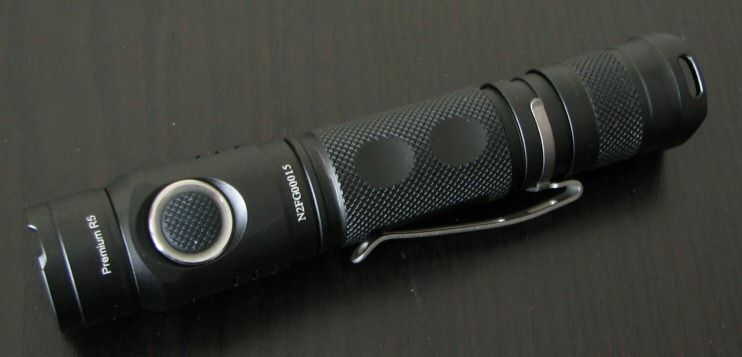
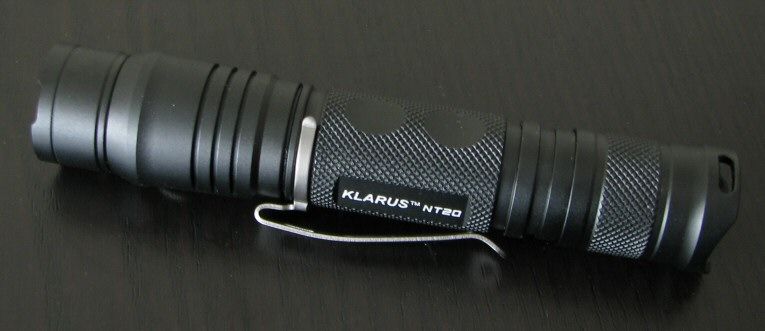
Clip seems to be fairly sturdy and good quality. It holds onto the light well, and can be positioned for bezel-up or bezel-down carry. But with all clips of this sort, there is always a risk the light might catch on something and be pulled off. The included holster seems good quality, and comes with a closing flap.
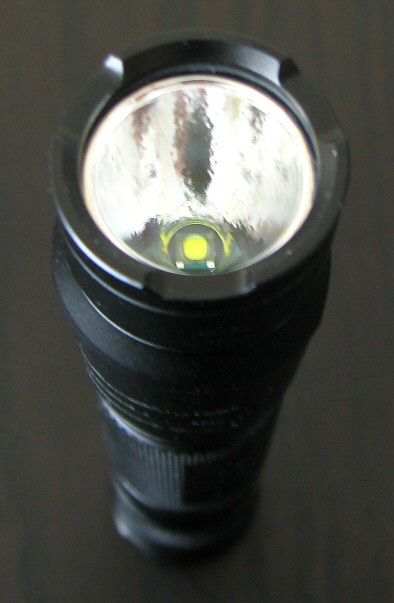
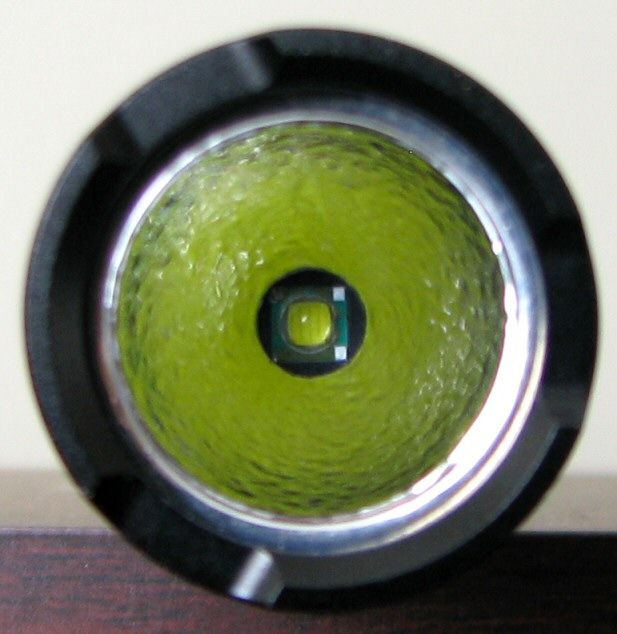
The NT20 features the Cree XP-G R5, with a medium textured orange peel (MOP) deep reflector.
Which brings us to the requisite white wall hunting . All lights are on Hi on 3.7V Li-ion rechargeable (AW 14670 for the NT20, AW18650 for the T20C2-II), about ~0.75 meter from a white wall (with the camera ~1.25 meters back from the wall). Automatic white balance on the camera, to minimize tint differences.
. All lights are on Hi on 3.7V Li-ion rechargeable (AW 14670 for the NT20, AW18650 for the T20C2-II), about ~0.75 meter from a white wall (with the camera ~1.25 meters back from the wall). Automatic white balance on the camera, to minimize tint differences.
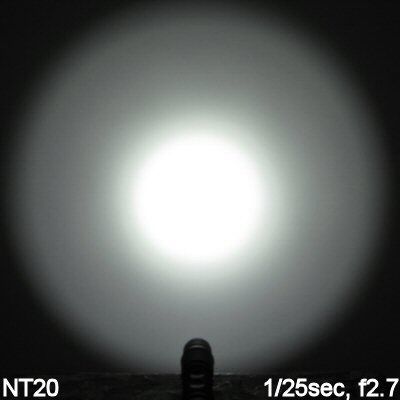
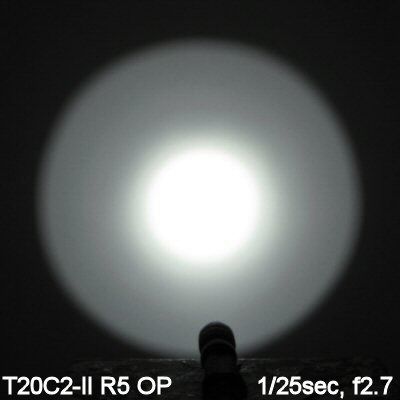
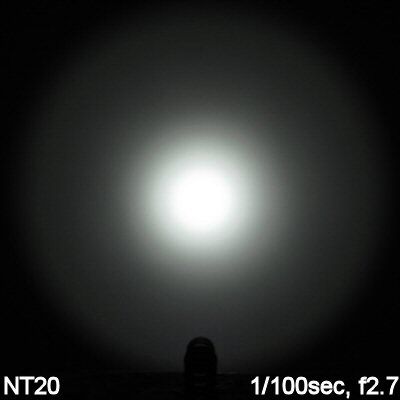
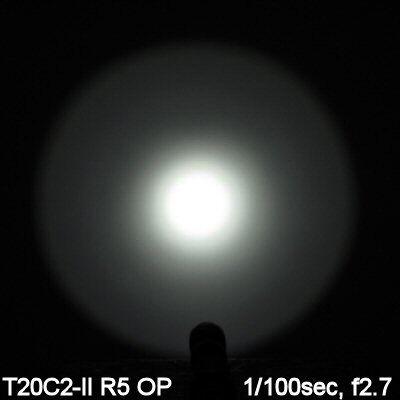
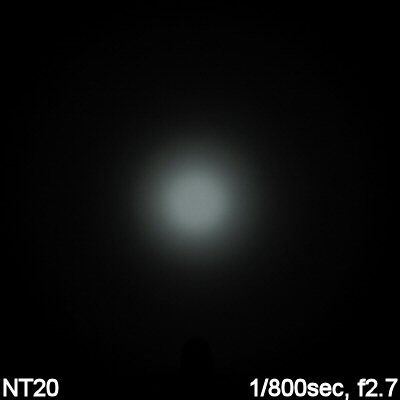
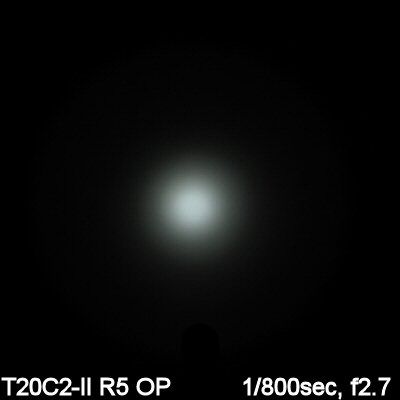
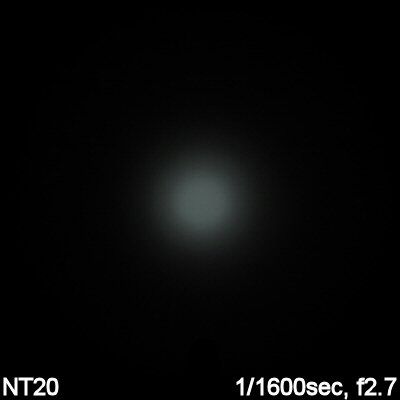
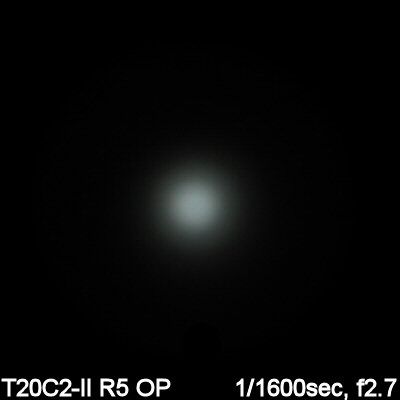
From now on, all my beamshots will be taken in this standard configuration, to facilitate comparisons.
As you can see, the NT20 has a nice and reasonably wide beam for this class. Scroll down to my Summary Tables for more specifics on output.
User Interface
The UI is fairly unique on these Klarus lights.
Turn the light on by pressing the tailcap clicky (press for momentary on, click for locked on).
With the head fully tightened, you get the regular modes. Press and release the side switch to change output levels. The output mode will change in the following sequence Lo > Med > Hi, in repeating order. The light will memorize the last mode used, and return to it upon re-activation.
With the head loosened (turn 1/8 turn counter-clockwise), you get the "Hidden" modes. Using the side switch, the output sequence is Super Lo > SOS > Beacon, in repeating order. Note there is no memory feature for the Hidden modes – the light will always come on in Super Lo (aka moonlight) upon activation with the head loosened.
Strobe is accessed from either mode state by pressing and holding the side switch for longer than half a second. As long as you hold the switch down, you will get a constant strobe mode. Release the switch, and a variable frequency strobe continues until you turn off the light or change modes (use the side switch to change to modes). Scroll down for the frequencies.
An interesting variant on the classic Fenix/4Sevens interface.
PWM and Strobe
The NT20 is current-controlled on its regular output modes (Lo, Med, Hi). It is just the "Super Lo" (aka moonlight) mode that uses PWM:
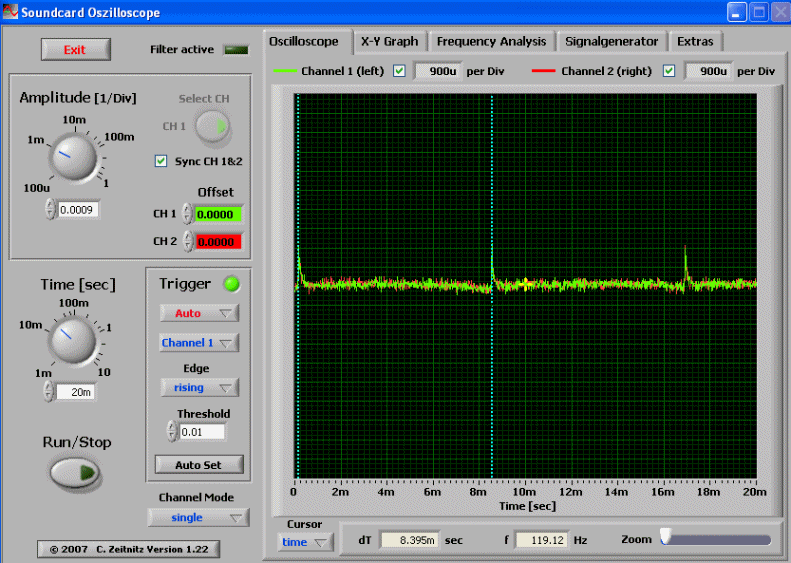
PWM on Super Lo is 120 Hz.
This is thus similar to the Zebralights, where current-control is used for regular modes (for max efficiency), and PWM is used for "moonlight" (for extended runtime at much lower output). :thumbsup:
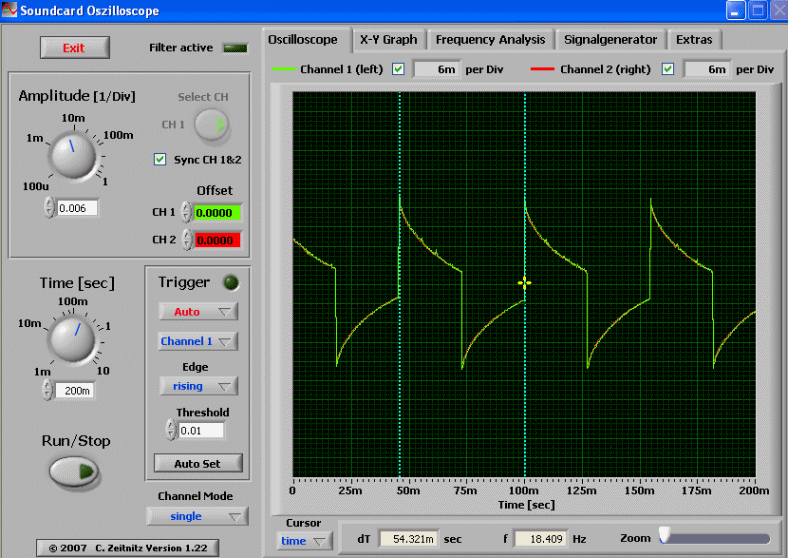
If you press and hold the side switch, the light strobes at a constant frequency of 18.4 Hz. Once you release the switch, however, the light continues to strobe at an oscillating pair of frequencies:
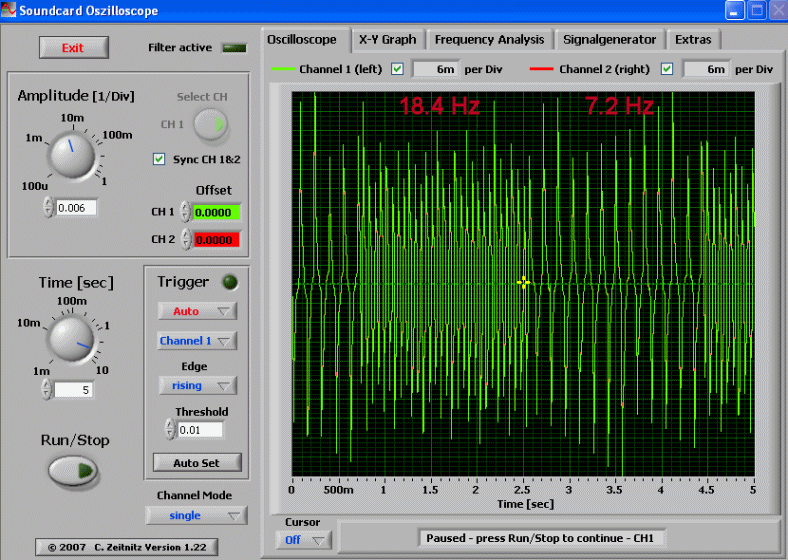
The light spends ~1.8 secs at 18.4Hz, followed by the same length of time at 7.2Hz, in a reoccurring cycle. Not sure of the point of this, but it is certainly annoying! :green:
Testing Method:
All my output numbers are relative for my home-made light box setup, a la Quickbeam's flashlightreviews.com method. You can directly compare all my relative output values from different reviews - i.e. an output value of "10" in one graph is the same as "10" in another. All runtimes are done under a cooling fan, except for any extended run Lo/Min modes (i.e. >12 hours) which are done without cooling.
I have recently devised a method for converting my lightbox relative output values (ROV) to estimated Lumens. See my How to convert Selfbuilt's Lighbox values to Lumens thread for more info.
Throw/Output Summary Chart:
Effective November 2010, I have revised my summary tables to match with the current ANSI FL-1 standard for flashlight testing. Please see http://www.sliderule.ca/FL1.htm for a description of the terms used in these tables.
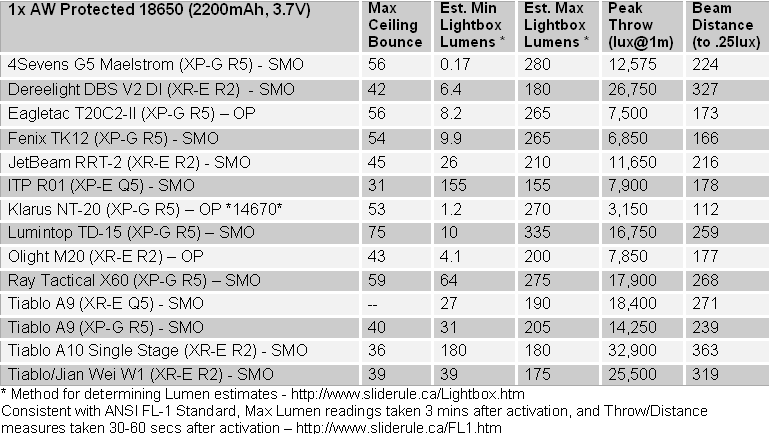
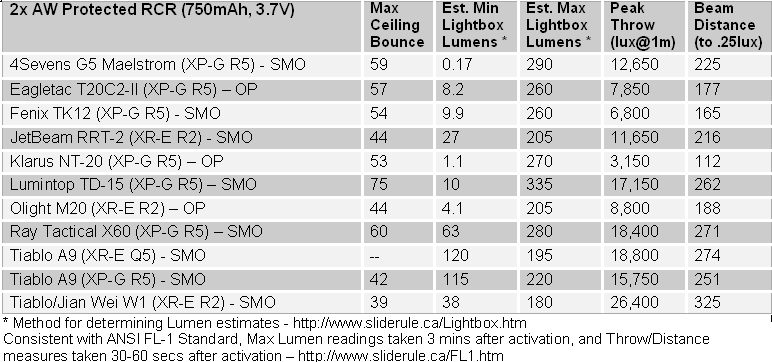
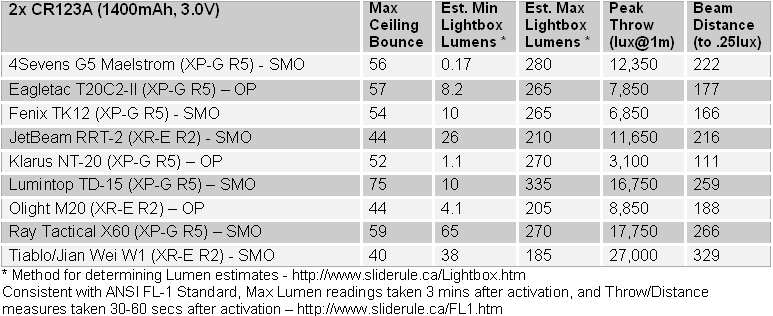
The max output of the NT20 seems very close to published specs, and is very similar to other maximally-driven XP-G R5 lights on 1x 3.7V Li-ion. On 2xRCR/CR123A, a number of the dedicated thrower lights push out more output (and throw, of course). In keeping with its size, I would say the NT20 is something of a general purpose light.
See my runtimes below for info on the relative output levels.
Output/Runtime Comparison:
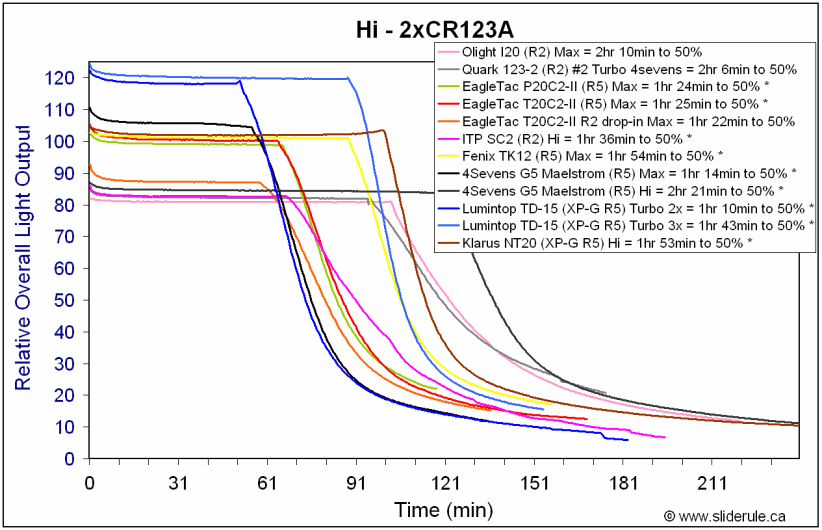
Note: 18650/17670 batteries wouldn't fit in my NT20, so runtimes below are based on the much lower capacity 14670.
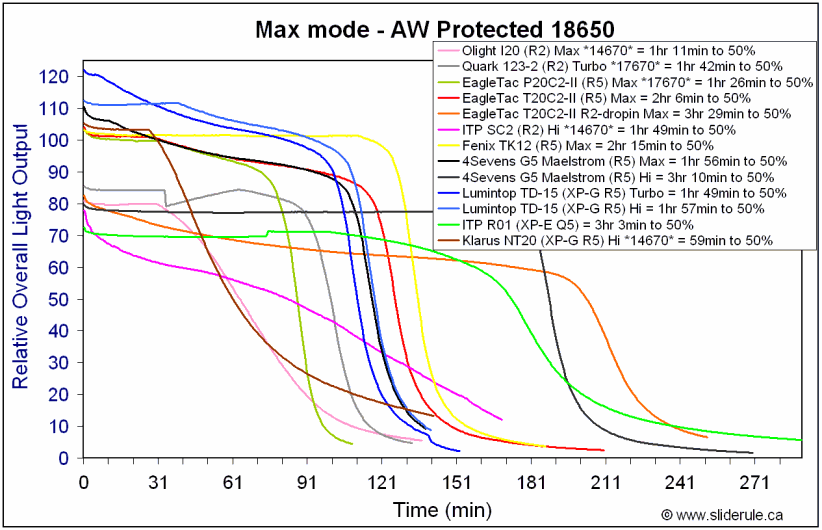
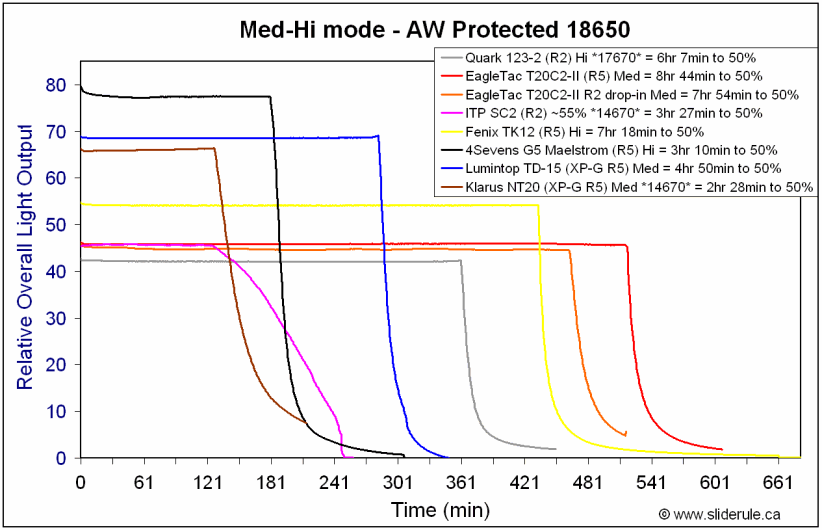
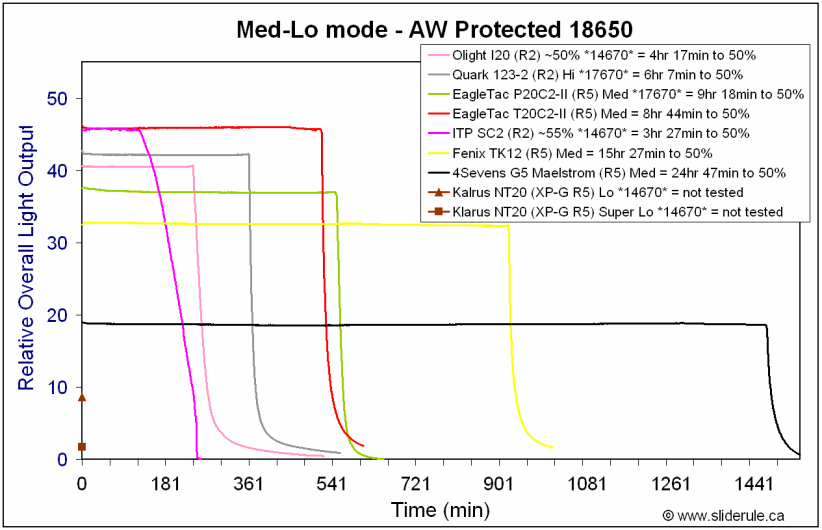
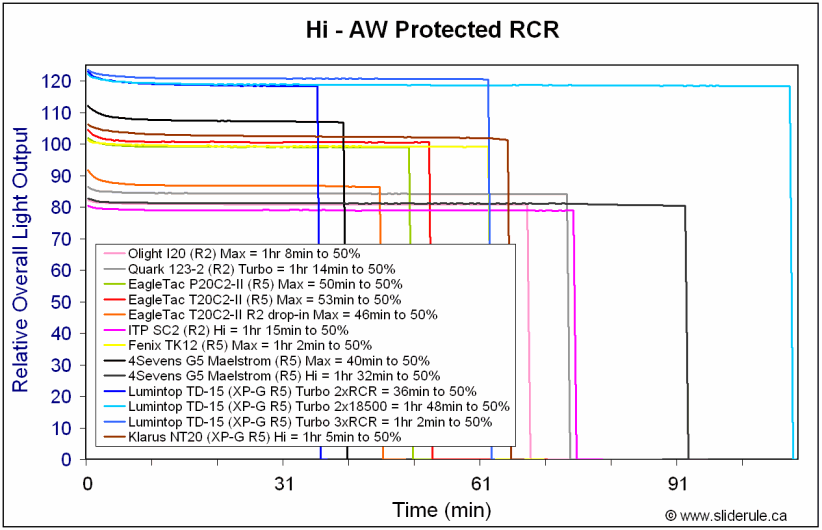
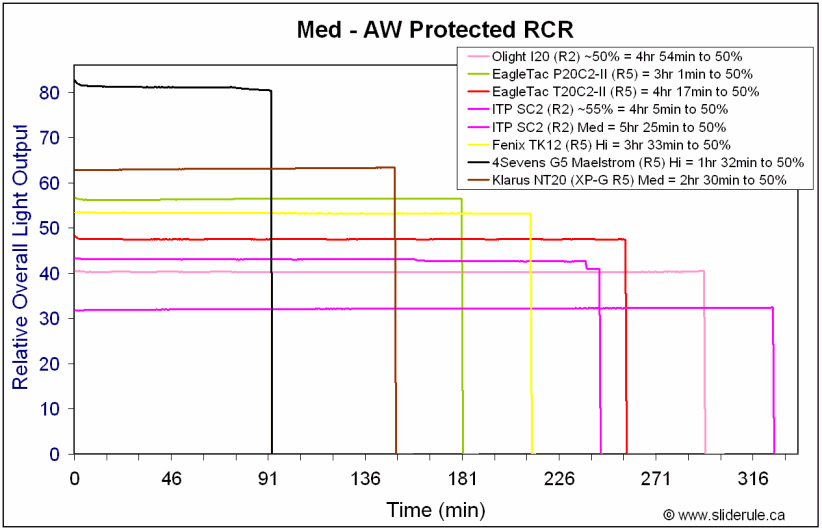
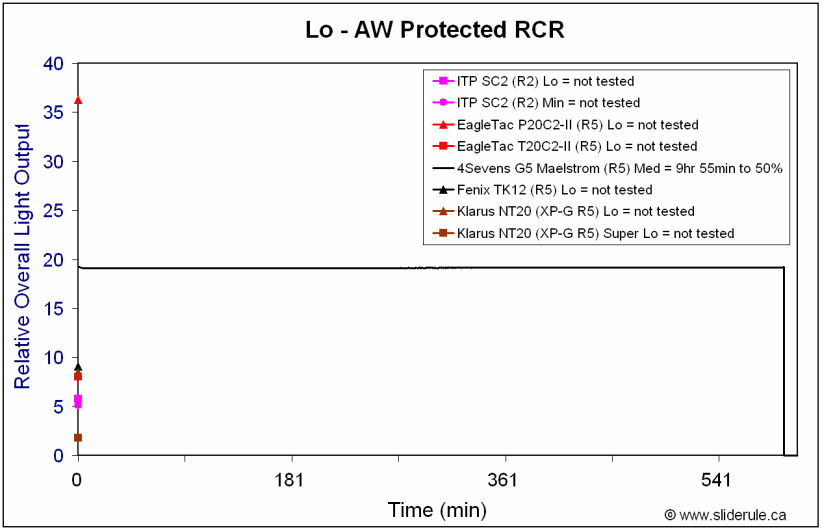
Output/runtime efficiency is excellent on the NT20, as expected for a good current-controlled light. :thumbsup:
Unfortunately, I don't have a Fenix PD30 to compare, but I think you would see a lot of similarity in relative output levels. What I found in my ST10 (1xAA) review is that the Hi/Med/Lo of the ST10 exactly matches the Turbo/Hi/Lo of the Fenix LD10-R4. So, basically, you are missing the Fenix Med mode, but you get the equivalent of the 4Sevens Quark Moonlight mode ("Super Lo" on the NT20) instead.
To help you compare the NT20 14670 runs to all the other 18650 lights, I find standard standard 2200mAh 18650 AW Protected batteries have nearly twice the capacity of my AW 14670 cells.
Potential Issues
Narrow body tube cannot accept 18650 or protected 17670 in my testing. Regular 16340 (RCR) or CR123A fit fine.
While my NT20 tailstands fine, some of these Klarus lights may be a bit wobbly.
Need to switch grip to change modes after turning on (i.e. rear tailcap for on-off, side switch for modes).
Strobe can be accidentally accessed if you hold down side switch too long while trying to change modes (i.e. greater than 0.5 secs).
Preliminary Observations
As mentioned in my ST10 (1xAA) review, I am pleased to see some of the new makes and models coming out these days. These new Klarus lights are good examples of solid lights, with excellent performance and a somewhat novel interface
The physical design and build is similar across the Klarus line (and suggest a quality manufacture). My only concern with the NT20 is the narrowness of the battery tube – neither protected 18650 nor 17670 would fit. But that's not uncommon on relatively compact lights like this (e.g. the Fenix PD30, Olight T20/I20, ITP SC2, all have the same issue).
There are a lot of nice design touches on the Klarus lights. Switch design seems good at both ends, with a good feel to both the rear on/off forward clicky switch and side level-changing electronic switch.
Mode changing is a little unusual, but should quickly become familiar to those used to the regular Fenix/Olight/4Sevens series (i.e. the head tight/loose for different mode sets). The main difference is the use of the side switch to select the levels within each set instead of the tailcap (i.e. like the ITP SA/SC series, or Lumapower MVP).
I found the UI quickly became intuitive (e.g. upon activation, head loose gives Super Lo, head tight for a memorized and selectable Lo/Med/Hi). I like the fact that you can ignore the various blinking modes if you don't want to see them. Personally, however, I am not a fan of "tactical" strobes in general purpose lights, and would rather see simple, slow strobe/beacon modes (~1-3 Hz range).
Output/runtime efficiency is one area where this light really performs. Like the ST10, the NT20 seems to share exact same current-controlled circuitry as the Fenix offerings in this space. In the case of the NT20, the relative spacing of Lo-Med-Hi (likely matched to the Fenix PD30 Lo-Hi-Turbo) works well. Coupled with the PWM-based Super Lo/Moonlight mode of the Klarus lights, you really get a good combination here.
I'm afraid that's it for my Klarus reviews for now, but I expect the ST20 and NT10 would show similar Fenix-like performance on their regular modes.
----
NT20 provided by goinggear.com for review.

Specifications:
- LED: Cree XP-G R5
- Lighting mode: 280 lumens (1.5hrs) - 9 lumens (52hrs) - 135 lumens (4.1hrs) - 2 lumens (200hrs)
- Flashing modes: SOS - (135 Lumen, 11.5hrs) - Beacon (135 Lumens, 60hrs) - Variable frequency strobe (280 Lumens, 3hrs)
- Working Voltage: 3.0-8.4V
- Battery: 2pcs 3-volt CR123A lithium battery.
- Tactical tail switch for power on and off with momentary activation
- Side switch for adjusting brightness output
- Rotate the flashlight head to access hidden modes (Super Low, SOS, Beacon)
- Strobe access: Press and hold the side switch for 0.5 seconds in any mode
- Lens: Toughened ultra-clear glass
- Material: Aircraft grade aluminum
- Dimensions: 125mm (Length) x 25.3mm (Head) x 21.5mm (Body)
- Net weight: 59g (Excluding battery)
- Waterproof to IPX-8 Standard
- Intelligent memory function (memorizes the last used lighting mode)
- High-efficiency digitally regulated output - maintains constant brightness
- Reverse polarity protection
- One hand operation
- Included accessories: holster, lanyard, body clip, two spare o-rings, and a rubber switch boot
- Estimated MSRP ~$65


As before, packaging is fairly standard. The light comes with a good number of extras. Inside the cardboard box with plastic insert is the light, manual, spare o-rings, extra boot cap, wrist strap, pocket clip, and belt holster (with closing flap).


From left to right: Energizer CR123A, Klarus NT20, ITP R01, Olight I20, ITP SC2, 4Sevens Quark 123-2, Fenix TK12
ST-10: Weight: 59.5 g (no battery), Length 124.9mm x Width 22.5mm (bezel) 25.2mm (widest area, near switch)



Build quality is excellent. Note the square-cut threads at both ends of the battery tube. Screw threads are anodized at the tailcap for lock-out. :thumbsup:
The switches both have a good feel. The tailcap switch is a typical forward clicky, and the side switch feels like an electronic switch (but with better than typical feedback).
My NT20 sample tailstands nicely, but I know this can be variable (i.e. my ST10 is rather wobbly). I suspect some adjustment of the clicky might help in those cases.
Light feels reasonably solid, if a bit top-heavy. Knurling is not very aggressive, but there are a lot of body ridge details to help with grip.
Anodizing is excellent on my sample, no chips in the flat black finish (HA = type III). Lettering is sharp and clear, nice and bright against the black background.
One point – the body tube is fairly narrow on the NT20. I found most protected RCRs (16340) and CR123A fit well, but with absolutely no extra wiggle room. None of my protected 17670 or 18650 cells would fit, so I had to use the much lower capacity 14670 for the 1x 3.7V Li-ion tests below. Something to keep in mind if you want to use rechargeables in this light.


Clip seems to be fairly sturdy and good quality. It holds onto the light well, and can be positioned for bezel-up or bezel-down carry. But with all clips of this sort, there is always a risk the light might catch on something and be pulled off. The included holster seems good quality, and comes with a closing flap.


The NT20 features the Cree XP-G R5, with a medium textured orange peel (MOP) deep reflector.
Which brings us to the requisite white wall hunting








From now on, all my beamshots will be taken in this standard configuration, to facilitate comparisons.
As you can see, the NT20 has a nice and reasonably wide beam for this class. Scroll down to my Summary Tables for more specifics on output.
User Interface
The UI is fairly unique on these Klarus lights.
Turn the light on by pressing the tailcap clicky (press for momentary on, click for locked on).
With the head fully tightened, you get the regular modes. Press and release the side switch to change output levels. The output mode will change in the following sequence Lo > Med > Hi, in repeating order. The light will memorize the last mode used, and return to it upon re-activation.
With the head loosened (turn 1/8 turn counter-clockwise), you get the "Hidden" modes. Using the side switch, the output sequence is Super Lo > SOS > Beacon, in repeating order. Note there is no memory feature for the Hidden modes – the light will always come on in Super Lo (aka moonlight) upon activation with the head loosened.
Strobe is accessed from either mode state by pressing and holding the side switch for longer than half a second. As long as you hold the switch down, you will get a constant strobe mode. Release the switch, and a variable frequency strobe continues until you turn off the light or change modes (use the side switch to change to modes). Scroll down for the frequencies.
An interesting variant on the classic Fenix/4Sevens interface.
PWM and Strobe
The NT20 is current-controlled on its regular output modes (Lo, Med, Hi). It is just the "Super Lo" (aka moonlight) mode that uses PWM:

PWM on Super Lo is 120 Hz.
This is thus similar to the Zebralights, where current-control is used for regular modes (for max efficiency), and PWM is used for "moonlight" (for extended runtime at much lower output). :thumbsup:

If you press and hold the side switch, the light strobes at a constant frequency of 18.4 Hz. Once you release the switch, however, the light continues to strobe at an oscillating pair of frequencies:

The light spends ~1.8 secs at 18.4Hz, followed by the same length of time at 7.2Hz, in a reoccurring cycle. Not sure of the point of this, but it is certainly annoying! :green:
Testing Method:
All my output numbers are relative for my home-made light box setup, a la Quickbeam's flashlightreviews.com method. You can directly compare all my relative output values from different reviews - i.e. an output value of "10" in one graph is the same as "10" in another. All runtimes are done under a cooling fan, except for any extended run Lo/Min modes (i.e. >12 hours) which are done without cooling.
I have recently devised a method for converting my lightbox relative output values (ROV) to estimated Lumens. See my How to convert Selfbuilt's Lighbox values to Lumens thread for more info.
Throw/Output Summary Chart:
Effective November 2010, I have revised my summary tables to match with the current ANSI FL-1 standard for flashlight testing. Please see http://www.sliderule.ca/FL1.htm for a description of the terms used in these tables.



The max output of the NT20 seems very close to published specs, and is very similar to other maximally-driven XP-G R5 lights on 1x 3.7V Li-ion. On 2xRCR/CR123A, a number of the dedicated thrower lights push out more output (and throw, of course). In keeping with its size, I would say the NT20 is something of a general purpose light.
See my runtimes below for info on the relative output levels.
Output/Runtime Comparison:

Note: 18650/17670 batteries wouldn't fit in my NT20, so runtimes below are based on the much lower capacity 14670.






Output/runtime efficiency is excellent on the NT20, as expected for a good current-controlled light. :thumbsup:
Unfortunately, I don't have a Fenix PD30 to compare, but I think you would see a lot of similarity in relative output levels. What I found in my ST10 (1xAA) review is that the Hi/Med/Lo of the ST10 exactly matches the Turbo/Hi/Lo of the Fenix LD10-R4. So, basically, you are missing the Fenix Med mode, but you get the equivalent of the 4Sevens Quark Moonlight mode ("Super Lo" on the NT20) instead.
To help you compare the NT20 14670 runs to all the other 18650 lights, I find standard standard 2200mAh 18650 AW Protected batteries have nearly twice the capacity of my AW 14670 cells.
Potential Issues
Narrow body tube cannot accept 18650 or protected 17670 in my testing. Regular 16340 (RCR) or CR123A fit fine.
While my NT20 tailstands fine, some of these Klarus lights may be a bit wobbly.
Need to switch grip to change modes after turning on (i.e. rear tailcap for on-off, side switch for modes).
Strobe can be accidentally accessed if you hold down side switch too long while trying to change modes (i.e. greater than 0.5 secs).
Preliminary Observations
As mentioned in my ST10 (1xAA) review, I am pleased to see some of the new makes and models coming out these days. These new Klarus lights are good examples of solid lights, with excellent performance and a somewhat novel interface
The physical design and build is similar across the Klarus line (and suggest a quality manufacture). My only concern with the NT20 is the narrowness of the battery tube – neither protected 18650 nor 17670 would fit. But that's not uncommon on relatively compact lights like this (e.g. the Fenix PD30, Olight T20/I20, ITP SC2, all have the same issue).
There are a lot of nice design touches on the Klarus lights. Switch design seems good at both ends, with a good feel to both the rear on/off forward clicky switch and side level-changing electronic switch.
Mode changing is a little unusual, but should quickly become familiar to those used to the regular Fenix/Olight/4Sevens series (i.e. the head tight/loose for different mode sets). The main difference is the use of the side switch to select the levels within each set instead of the tailcap (i.e. like the ITP SA/SC series, or Lumapower MVP).
I found the UI quickly became intuitive (e.g. upon activation, head loose gives Super Lo, head tight for a memorized and selectable Lo/Med/Hi). I like the fact that you can ignore the various blinking modes if you don't want to see them. Personally, however, I am not a fan of "tactical" strobes in general purpose lights, and would rather see simple, slow strobe/beacon modes (~1-3 Hz range).
Output/runtime efficiency is one area where this light really performs. Like the ST10, the NT20 seems to share exact same current-controlled circuitry as the Fenix offerings in this space. In the case of the NT20, the relative spacing of Lo-Med-Hi (likely matched to the Fenix PD30 Lo-Hi-Turbo) works well. Coupled with the PWM-based Super Lo/Moonlight mode of the Klarus lights, you really get a good combination here.
I'm afraid that's it for my Klarus reviews for now, but I expect the ST20 and NT10 would show similar Fenix-like performance on their regular modes.
----
NT20 provided by goinggear.com for review.
Last edited:

